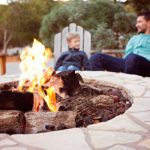Outdoor Residential Fire Pit Burning Regulations
January 25, 2024 8:05 pm Leave your thoughts
1. Check Local Regulations
Before installing or using a fire pit in your outdoor space, it is crucial to familiarize yourself with the local regulations and restrictions in your area. Each municipality or county may have specific rules regarding the use of fire pits, including size limitations, setback requirements, and restrictions on burning certain materials. Contact your local fire department or zoning office to obtain the necessary information and permits.
2. Maintain Safe Distances
To reduce the risk of fire spread and property damage, it is important to maintain safe distances between the fire pit and any surrounding structures. Most jurisdictions require a minimum distance of at least 10 feet between the fire pit and any structures, such as your home, trees, or fences. This ensures that sparks and embers from the fire are less likely to ignite flammable materials nearby.
3. Choose a Safe Location
Selecting a safe location for your fire pit is crucial to prevent accidents and ensure the overall safety of your outdoor space. It should be positioned on a non-combustible surface, such as concrete or pavers, to minimize the risk of fire spreading to the surrounding area. Avoid placing the fire pit on wooden decks or grassy surfaces, as these are more susceptible to catching fire.
4. Use Appropriate Fire Pit Designs
When choosing a fire pit, it is important to select a design that meets safety standards and provides adequate containment of the fire. Opt for fire pits with a sturdy construction, such as those made from metal or stone, and avoid lightweight or flimsy options. Additionally, consider fire pits with proper ventilation to ensure a steady flow of oxygen and prevent the build-up of smoke and carbon monoxide.
5. Burn Only Appropriate Materials
Most jurisdictions have strict guidelines on what materials can be burned in residential fire pits. Generally, only dry, seasoned firewood should be used as the primary fuel source. Avoid burning treated wood, painted materials, plastics, or any other materials that can release toxic fumes or create unnecessary pollution. It is best to check with your local fire department for a comprehensive list of approved burnable materials.
6. Keep a Fire Extinguisher Handy
Safety should always be a top priority when using a fire pit. Keep a suitable fire extinguisher nearby, such as an ABC or multi-purpose extinguisher, in case of any emergencies. Familiarize yourself with its proper usage and ensure that it is readily accessible. Additionally, keeping a bucket of sand or a garden hose nearby can also help in extinguishing the fire if needed.
7. Monitor the Fire at All Times
It is essential to closely monitor the fire at all times when it is burning. Never leave the fire pit unattended, especially when children or pets are present. Wind can cause embers to travel beyond the boundaries of the fire pit, increasing the risk of fire spread. Always have a responsible adult present to supervise the fire and extinguish it completely before leaving the area.
8. Respect Fire Bans and Weather Conditions
During dry or windy conditions, local authorities may impose temporary fire bans or restrictions. It is crucial to respect these guidelines and refrain from using your fire pit until the ban is lifted. Additionally, exercise caution when using the fire pit in adverse weather conditions, such as strong winds, as this can increase the risk of fire accidents.
Summary
Enjoying an outdoor fire pit can be a wonderful experience, but it is important to follow the regulations and guidelines in your area to ensure safety and compliance. Checking local regulations, maintaining safe distances, choosing a suitable location, and using appropriate fire pit designs are key considerations. Burning only approved materials, having fire extinguishing equipment on hand, monitoring the fire at all times, and respecting fire bans and weather conditions are additional steps to ensure a safe and enjoyable outdoor fire pit experience.
Need a Custom Fireplace Contractor in Seattle, WA?
Locally owned and operated since 2008, Custom Fire Art has built a reputation for providing excellent workmanship, dependability, and professionalism to the residents and businesses of Fall City and its surrounding areas. Our team of skilled and knowledgeable technicians specializes in creating custom fixtures for indoor and outdoor fireplaces, fire pits, outdoor kitchens, patios, and grills. Our goal is to produce elements that are both carefully made and artistically appealing. Visit our site to see more of our work to get an idea of what we can make for you! Custom Fire Art is a licensed and bonded contractor, so give us a call today, and we will be more than happy to get you started on your next project.
Categorised in: Fire Pits
This post was written by admin
